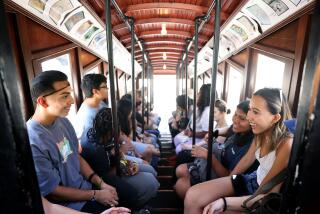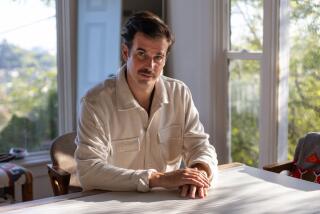Americans Encounter the Soviet Curious
ON THE ROAD TO MOSCOW — Last Saturday, as crowds gathered by a bridge in the 12th-Century city of Kalinin to watch the American and Soviet peace walkers cross the Volga, several old women stood solemnly holding richly ornamented icons over their heads.
Many of the 230 Americans, who are walking about 360 miles from Leningrad to Moscow with 200 Soviets, stopped to snap photos of them. A Soviet film crew documenting the peace walk also spotted them, brought one out from the crowd, posed her and started shooting. She stood there, looking defiant, another old woman standing staunchly at her side.
Vladimir Glushchenko, a young translator from Radio Moscow who is part of the Soviet delegation, explained, “That is very Russian, a very old Russian tradition. When something sacred was happening, they would bring the icons out to bless the people. She was bringing the most sacred things from her house to bless us.”
And indeed, one of the old women had blessed the Helms, a Christian family from Washington, carefully making the sign of the cross with the icons over the parents and their four children.
On the following day--the 11th day of the walk, which is due in Moscow late today--some of the walkers, including a few Soviets, went to services at the Russian Orthodox church called Belya Troitsa, or White Trinity. Father Viktor Alaikin, a peace walker himself, serves there.
The church, in a quiet, old neighborhood of tree-lined streets and old wooden cottages with ornate trim, was filled mostly with old women, their visitors, the peace walkers and the Soviet camera crew.
The services, led by the metropolitan (bishop) of the area, went on for two hours--the air filled with singing, incense, candles and people--before the metropolitan interrupted the normal course to introduce the visitors.
He blessed them and the walk and introduced Judy Imai of Santa Barbara. Wearing a T-shirt lettered “No More Hiroshimas,” she lit a church candle from a lantern she was carrying that had been itself lit from the eternal flame at the Hiroshima Peace Garden.
Through an interpreter, the metropolitan told the visitors: “You can see our believers can really pray in the church, and they pray first of all for peace.”
Outside in the courtyard, security was keeping the area clear. A few onlookers stood on the other side of a picket fence. Two Americans sat on the church steps taking a breather. When a Soviet man and his daughter did the same, making a few stabs at an English greeting, security shooed him from the courtyard, mentioning “Americanski.” It was done in good humor, and the man took it that way, throwing up his hands, laughing and moving his daughter away.
The Americans have stepped through the looking glass on this Soviet/American Walk to end the arms race. (As of last weekend, they have been joined by actress Betty Thomas, formerly of “Hill Street Blues,” disc jockey Casey Kasem and his wife, actress Jean Kasem.) They are getting a rare experience of Soviet society that is complicated, frequently confusing and full of surprises.
Consider the baths. On Friday night in Kalinin, about 100 of the walkers went to the local baths by bus, a police escort stopping all traffic along the way.
At the baths, it was no longer Soviets and Americans, but men to the left and women to the right. Within moments, the women had stripped down and were in a very hot wooden sauna. And there they stood, the Soviets laughing at the yelping, gasping Americans while they obligingly beat the backs of their visitors with fragrant wet birch leaves.
Outside in the shower room, some of the Soviet women took sponges that seemed made of shredded paper and scrubbed what was left of the American flesh, before directing the American women toward one final shrieking moment under an icy shower.
The 200 Soviets walking, camping and living with the Americans include students, war veterans, a few laborers and a large number of professional people: musicians, political scientists, teachers, journalists, translators and disarmament specialists. They have been selected by the official Soviet Peace Committee and its regional affiliates (co-sponsors of the march with the private American organization, International Peace Walk Inc.).
Of the adults, about 70% to 80% of them are Communist Party members, Igor Filin, in charge of the walk for the Soviet Peace Committee, estimated--a high percentage in a country where party members make up about 5% of the general population.
Regardless, the Soviets seem, almost without exception, to be people who have high hopes for glasnost and reconstruction of a society that they are saying has been crippled by entrenched, unbending bureaucrats. They seem to see the walk as a chance to promote this “new thinking,” as they call it. They are anxious to present and explain their country to the Americans.
Seeking an Answer
“Are you satisfied with what you have seen so far?” one Soviet named Petr asked Judy Brock, an actress from Los Angeles, as the two of them stood tuning out yet another speaker at yet another official welcome--this time to a state farm in Seltso. “You don’t feel any restrictions?”
Brock floundered around amicably for a “yes . . . no . . . don’t know” answer to a question many Soviets are asking. Like the other Americans, she was seeing so much, but had no real way of knowing what she was not seeing.
At Seltso, which is a state farm and training center that has about 2,000 workers in the community, virtually everyone turned out for the welcome, with many lingering to watch in fascination as the walkers put up their tents. After dinner, and after the formal entertainment, they lit a huge bonfire and stood around it swatting mosquitoes and singing.
Conversation groups formed on the fringes of the circle, and long into the night the farm workers and their guests talked hungrily of the troubled economies of both superpowers, posing questions about capitalism versus Marxism, arguing about Afghanistan, asking about Nicaragua, music, marriage, salaries, divorce and glasnost.
One worker, who said he was a physicist, talked with an American about reconstruction. While a small group of teen-age boys--all struggling with English--gathered, the physicist said he supported the changes that reconstruction was bringing. People now had to work to make it happen; it was up to them, he said.
“What do you think of the changes?” he asked the American. “Do you think they have improved the living standard?”
An American on a short visit could only judge by what the Soviets themselves were saying, the American answered, and then asked what changes it had brought to the physicist’s life.
“The policy has been pursued for a year and a half only,” came the somewhat abrupt answer. “It is too early to speak of changes.”
One thing was certain, he said. The Soviet/American Walk was part of the change. “This should have happened a long time ago,” he said. “I’m happy it is happening now. Few people in America know much about this country.”
The Americans are seeing thousands of Soviets in planned ceremonies and chance encounters. They are visiting towns and villages, where seldom, if ever, Americans are seen, especially in large numbers.
The considerable number of security personnel on the walk often openly turn away those who approach the campsites or the Americans. The Soviets say it is to avoid being swamped by the curious and to protect against theft and black-market approaches, and few can argue against that, considering the amount of expensive gear the Americans have with them.
Beyond that, it seems to many Americans that glasnost or not, Soviet authorities are uncomfortable with open access and seek to control it. At the same time, it is equally true that the Americans are able to roam at will, approach and meet whom they please, visit homes and seemingly proceed unchecked.
Exhausting Experience
It has been for most a physically exhausting and emotionally overwhelming experience, and they are on sensory overload. It is, they are saying to each other and to those Soviets they are coming to know well, folly to draw many conclusions.
On Monday, a rainy morning, the peace walkers pitched their tents for a two-night stay at a camp outside of Klin, and then most went off to a strawberry farm. A few Americans and many of the Soviet organizers stayed behind to work and make phone calls at a nearby dormitory.
An American knocked perfunctorily on the door of what was reported to be the press room and entered without waiting for an answer. Seven or eight Soviets sitting in the smoke-filled room wheeled around startled.
Aha. So, this must be one of those secret meetings they hold every time the Americans are not around.
Maybe so. The Soviets had a VCR hooked up to a television. And there on the screen were Dan Aykroyd and John Belushi in dark suits, fedoras and shades.
The Soviets were watching “The Blues Brothers.”
More to Read
Sign up for Essential California
The most important California stories and recommendations in your inbox every morning.
You may occasionally receive promotional content from the Los Angeles Times.










